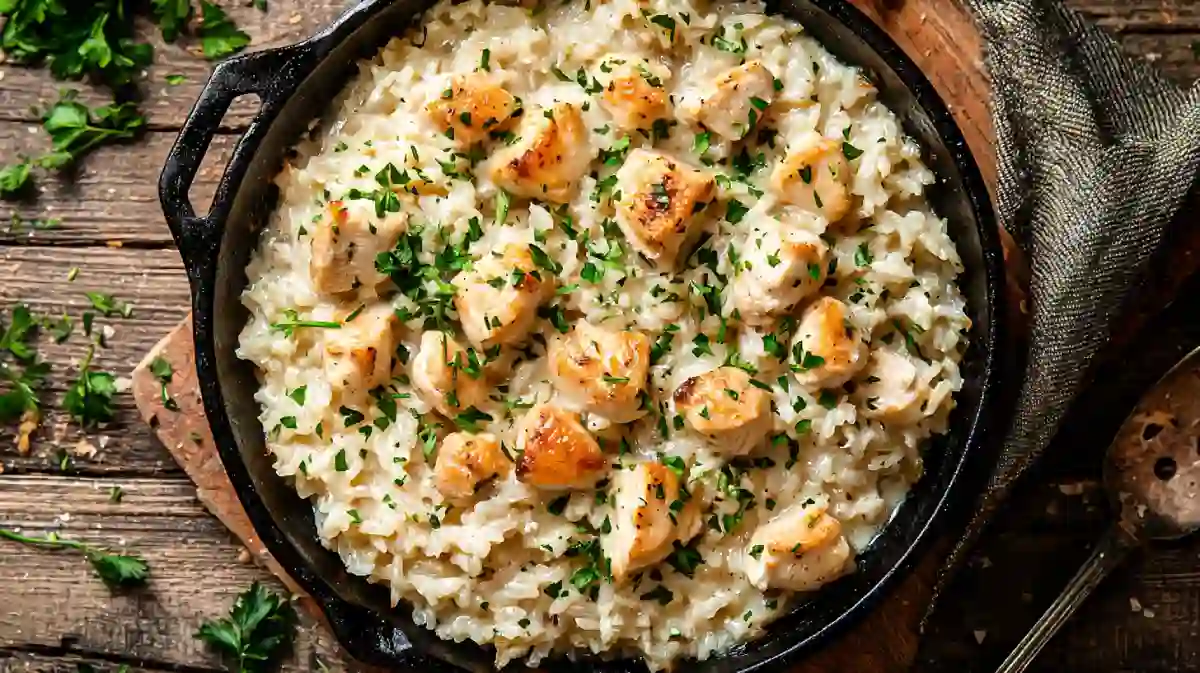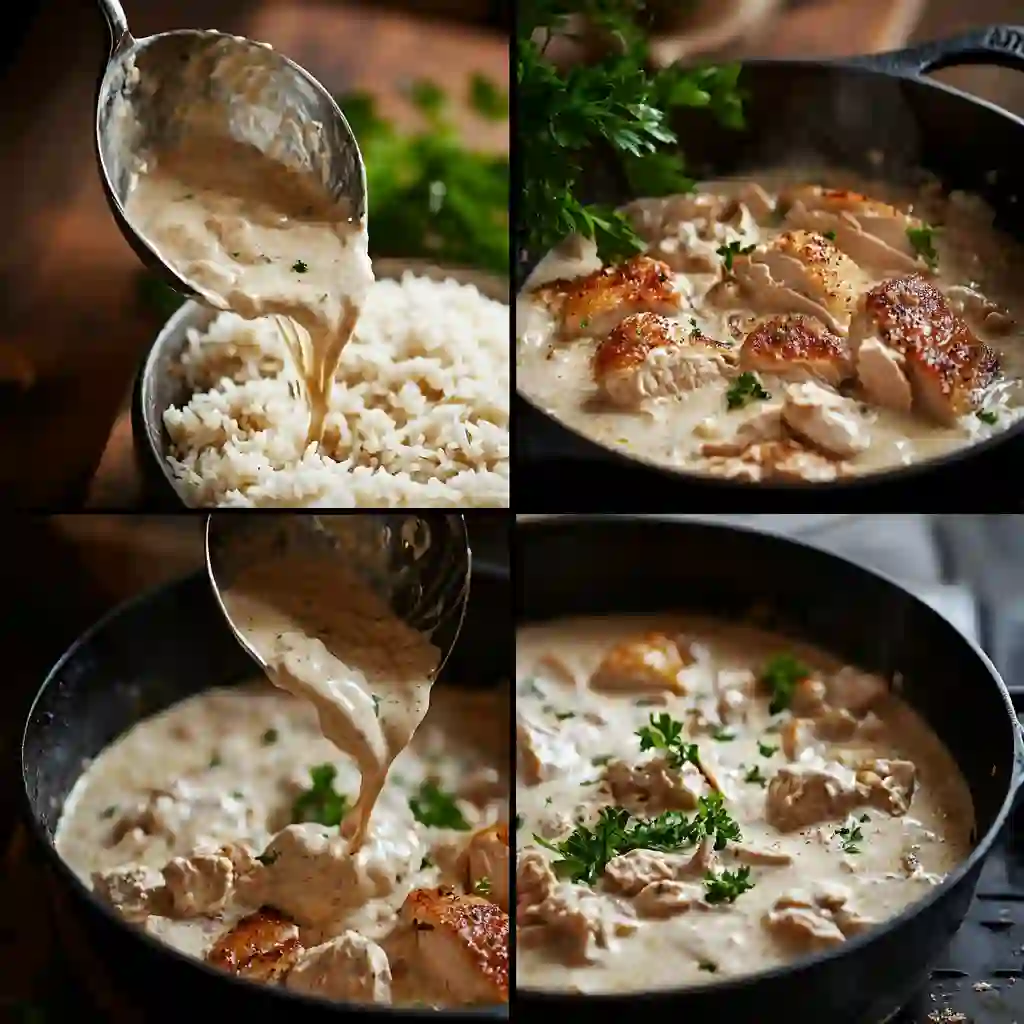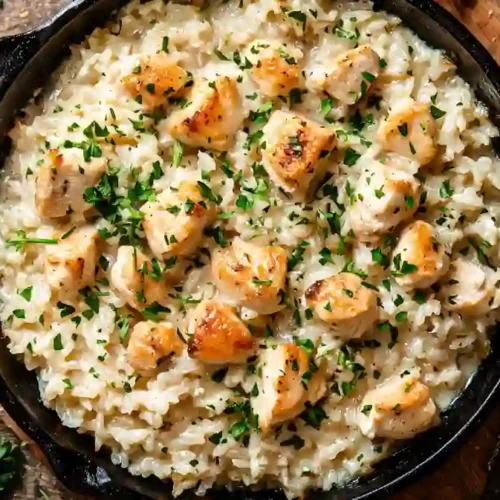
Table of Contents
I’ve rediscovered the forgotten chicken recipe as my ultimate go-to for comfort and convenience: tender chicken simmered in creamy soup atop fluffy rice, all in one pot for a soul-warming meal you can pull together in under an hour. Its simplicity makes it perfect for busy weeknights or family gatherings alike.
Ingredients for Forgotten Chicken Recipe
Creating the perfect forgotten chicken recipe begins with selecting the right ingredients. Not only do these staples come together to create a delicious and satisfying dish, but they also make preparation simple and enjoyable. By choosing fresh and high-quality items, you ensure a meal that will impress every time.
Basic Ingredients
- Chicken: For the best results, use boneless chicken breast or thighs, which are both tender and flavorful.
- Rice: Long-grain white rice is ideal since it cooks evenly and has a light, fluffy texture.
- Cream of Mushroom Soup: This ingredient adds the signature creamy flavor that makes this recipe unforgettable.
- Broth or Water: While chicken broth enhances the dish’s flavor, water can be used for a lighter taste.
- Seasonings: Simple seasonings like salt, pepper, and garlic powder bring out the natural flavors of the other ingredients.
Optional Ingredients for Customization
- Cheese: Adding cheddar or Parmesan creates a richer, more indulgent flavor.
- Vegetables: Including peas, carrots, or mushrooms not only adds color but also boosts nutritional value.
- Herbs: Fresh parsley or thyme can be used to add a hint of aromatic freshness.
For those who want to make healthier choices, resources like EatRight provide excellent tips on selecting nutritious ingredient alternatives. Additionally, incorporating some vegetables into the dish can add both flavor and essential nutrients.
If you’re looking for similar ideas to complement your meals, try this delicious chicken alfredo garlic bread recipe on Flavivorecipes. Not only does it pair well with this dish, but it also offers a quick and satisfying option for weeknight dinners.
Step-by-Step Cooking Instructions
Preparing the forgotten chicken recipe is not only straightforward but also incredibly rewarding. By following these steps carefully, you’ll achieve a dish that’s tender, flavorful, and perfect for any occasion. Let’s dive into the process and bring this classic comfort meal to life.

1. Preparation
- First, preheat the oven to 350°F (175°C). While the oven heats, gather all your ingredients for easy access.
- Next, prepare the chicken by trimming any excess fat and seasoning the meat generously with salt, pepper, and garlic powder.
2. Layer the Ingredients
- To begin, spread a thin layer of uncooked rice evenly in a baking dish.
- Then, place the seasoned chicken on top of the rice, ensuring an even distribution for balanced flavors.
- Afterward, pour cream of mushroom soup and chicken broth over the chicken and rice. This mixture not only provides moisture but also creates the creamy base for the dish.
3. Bake to Perfection
- Before baking, cover the dish tightly with aluminum foil to trap the steam, which helps cook the rice evenly.
- Now, place the dish in the oven and bake for 1 hour.
- Finally, check if the rice is tender and the chicken is cooked through. If needed, bake for an additional 10 minutes to ensure perfect doneness.
For a more detailed guide on similar one-dish recipes, you can explore Savvy Mama Lifestyle, which offers practical cooking tips and inspiration.
If you’re searching for another hearty and satisfying dish, try this buttermilk ranch grilled chicken wings recipe on Flavivorecipes. It’s a perfect addition to any family meal.
Nutritional Information and Health Benefits
The forgotten chicken recipe is not only a comforting classic but also a nutritious choice for family meals. While its creamy and flavorful nature makes it a favorite, understanding its nutritional value can help you make informed dietary choices.
Key Nutritional Benefits
- High in Protein: The chicken in this recipe provides a lean source of protein, which is essential for muscle repair and overall health.
- Rich in Carbohydrates: The rice offers a steady supply of energy, making it a great option for active individuals or busy families.
- Essential Vitamins and Minerals: Cream of mushroom soup often includes key nutrients like vitamin D and selenium, which support bone health and immune function.
To explore how you can adjust this recipe for different dietary needs, check out the Recipe Analyzer by HappyForks. This tool allows you to input ingredients and assess their nutritional content in detail.
Ways to Make it Healthier
- Swap Ingredients: Replace white rice with brown rice for added fiber, or use low-sodium chicken broth to reduce sodium content.
- Include Vegetables: Adding ingredients like broccoli, carrots, or peas can boost the dish’s vitamin and fiber levels.
- Choose Lighter Options: Opt for reduced-fat cream of mushroom soup to lower overall calorie and fat content.
If you’re looking for another nutritious recipe that balances flavor and health, consider trying this fried rice with frozen vegetables recipe on Flavivorecipes. It’s an excellent complement to a well-rounded meal plan.
Variations of the Forgotten Chicken Recipe
The forgotten chicken recipe is a versatile dish that allows for endless customization. Whether you need to adapt it for dietary needs or want to add a creative twist, there are plenty of ways to reinvent this classic. Below are some popular variations to try, ensuring everyone at the table can enjoy this comforting dish.
1. Gluten-Free Option
- Use Gluten-Free Soup: Replace the cream of mushroom soup with a gluten-free version. This ensures the creamy texture without compromising dietary restrictions.
- Substitute Rice: Opt for a gluten-free grain, such as quinoa, which is both nutritious and flavorful.
2. Vegan Adaptation
- Replace Chicken: Swap the chicken with plant-based alternatives, such as tofu or jackfruit.
- Vegan Cream Sauce: Use coconut milk or a vegan cream soup for the sauce.
- Add Vegetables: Load the dish with hearty vegetables like zucchini, bell peppers, and mushrooms for added texture.
3. Kid-Friendly Version
- Milder Flavors: Reduce the seasoning to create a milder dish that appeals to young palates.
- Cheesy Delight: Add extra cheese for a gooey, kid-approved topping.
- Include Fun Shapes: Use rice shaped like stars or animals to make the meal more appealing to children.
Frequently Asked Questions (FAQs)
The forgotten chicken recipe is a classic dish, but there are often questions about how to prepare and customize it. Below are answers to the most common queries to help you create a dish that’s perfect for your needs.
1. Can I Use Other Types of Meat in This Recipe?
Yes, turkey can be used as a substitute for chicken, though cooking times should be adjusted to ensure it is fully cooked while remaining tender.
2. How Do I Store and Reheat Leftovers?
Store leftovers in an airtight container and refrigerate for up to three days. Reheat gently in the microwave or oven, adding a splash of broth to maintain moisture.
3. What Sides Go Best with This Dish?
Pairing Suggestions: Steamed vegetables, fresh salads, or crusty bread are excellent choices to complement the creamy rice and chicken.
For more ideas, explore the ultimate guide to side dishes for chicken recipes on Flavivorecipes.
4. Can I Make This Recipe in a Slow Cooker?
Absolutely! Combine all ingredients in the slow cooker and cook on low for 6–7 hours. This method is ideal for busy days.
5. How Long Does It Take to Prepare and Cook?
Preparation takes about 10 minutes, while baking requires around one hour. Check for doneness by ensuring the rice is tender before serving.
6. How to cook chicken to reduce fat?
To reduce fat when cooking chicken, choose lean cuts like skinless breasts, trim visible fat, and use healthy methods such as grilling, baking, steaming, or poaching. Avoid frying or breading, and drain excess fat if pan-cooking. Enhance flavor with low-fat marinades like citrus juice or yogurt.
Conclusion
The forgotten chicken recipe is a dish that effortlessly combines simplicity, versatility, and timeless appeal. Its ability to adapt to different tastes and occasions makes it a staple in households around the world. Whether you’re recreating a family favorite or trying it for the first time, this recipe has a way of bringing people together.
In addition to its ease of preparation, the forgotten chicken recipe offers an opportunity to explore creativity in the kitchen. From experimenting with ingredients to incorporating personal touches, this dish invites you to make it your own. Moreover, its rich history and cultural significance remind us of the joy that comfort food can bring to our lives.
As we’ve seen throughout this guide, mastering the forgotten chicken recipe is not only simple but also highly rewarding. With its balance of flavor and practicality, it’s no surprise that this classic dish continues to stand the test of time. By trying this recipe and sharing it with others, you’re contributing to a legacy that connects generations through the love of food.
Finally, we encourage you to revisit the recipe often and discover new ways to enjoy it. Whether it’s a quick weeknight meal or a centerpiece for a special gathering, the forgotten chicken recipe is always a reliable choice. So, gather your ingredients, preheat your oven, and let this dish remind you of the magic of home-cooked meals.

Forgotten Chicken Recipe
Ingredients
- 2 cups instant rice uncooked
- 1 can 10.5 oz cream of chicken soup
- 1 can 10.5 oz cream of mushroom soup
- 1 can 10.5 oz water (use one of the empty soup cans to measure)
- 1 lb boneless skinless chicken breasts (approximately 4-5 pieces)
- 1 envelope onion soup mix
- Butter or non-stick cooking spray for greasing the baking dish
Instructions
- Preheat Oven: Set your oven to 350°F (175°C).
- Prepare Baking Dish: Grease a 9×13-inch baking dish with butter or non-stick cooking spray.
- Mix Ingredients: In a medium mixing bowl, combine the uncooked instant rice, cream of chicken soup, cream of mushroom soup, and one can of water. Stir until well mixed.
- Assemble Dish: Pour the rice and soup mixture into the prepared baking dish, spreading it evenly. Place the chicken breasts on top of the rice mixture in a single layer.
- Add Seasoning: Sprinkle the onion soup mix evenly over the chicken breasts.
- Bake: Cover the baking dish tightly with aluminum foil and bake in the preheated oven for 1 hour and 30 minutes, or until the chicken is cooked through and the rice is tender.
- Serve: Once done, remove from the oven and let it sit for a few minutes before serving.
Notes
- Rice Options: While instant white rice is commonly used, instant brown rice can be substituted for added nutrition. Note that using regular (non-instant) rice may require adjustments in liquid and cooking time.
- Soup Variations: Feel free to experiment with different cream soups, such as cream of celery or cream of broccoli, to alter the flavor profile.
- Additional Add-ins: Incorporate vegetables like frozen peas, carrots, or mushrooms into the rice mixture before baking for a complete one-dish meal.
- Cheese Topping: For an extra layer of flavor, sprinkle shredded cheddar cheese over the top during the last 10 minutes of baking.
- Leftovers: Store any leftovers in an airtight container in the refrigerator for up to 3 days. Reheat in the oven or microwave until warmed through.
